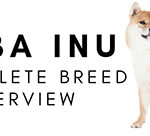Table of Contents
A Brief History
Although Monica Dickens, great-granddaughter of Charles Dickens, is credited with producing the first Goldendoodles in 1969, intentional, intensive breeding did not begin until the 1990s. These new “designer dogs” rapidly gained popularity as word spread of their excellent temperament, intelligence, and low shedding qualities.
First developed to be multipurpose service dogs, particularly guide dogs for the blind, Goldendoodles quickly rose in status and were sought after as companion animals and family pets. Today, breeders across the country make use of genetic testing and newfound knowledge to produce good-natured dogs who are more allergy-friendly than most breeds and who shed very little.
Goldendoodle Temperament
Goldendoodles were bred with the hope that the resulting pups would inherit the most desirable features of both the parent breeds, and that is exactly what happened. These hybrid puppies are hard to beat as far as personality goes and clearly are big winners in the “genetic lottery” that determines temperament.
The list of positive adjectives to describe Goldendoodles’ temperament could go on and on, and owners of this wonderful crossbreed are often hard-pressed to come up with any negative words to describe their personalities.
Goldendoodles are very intelligent, even-tempered, playful, gentle, non-aggressive, loyal, highly affectionate, and friendly to all. They are eager to please their owners, so training is usually fun and easy, and obedience seems to come naturally.
Goldendoodles are ordinarily full of energy and will gladly participate in all kinds of activities and games. They are people-oriented, full of love, and always ready for snuggles.
There are only a few negative aspects of this crossbreed. They do not make the best watchdogs as they are more likely to warmly welcome an intruder than to chase him away. The second negative is that, due to their retriever heritage, they can be a bit mouthy as puppies and should be given lots of chew toys to discourage destructive chewing.
The final downside is that they are not immortal. Many owners would agree that this is the one thing they would change about the Goldendoodle if it were in their power to do so. They really are that awesome!
Is a Goldendoodle a Good Family Dog?
A Goldendoodle is an excellent family dog. This gentle crossbreed is loving, easy to train and quite sociable. They want to be a part of family life and to remain close to their owners. They usually get along quite nicely with other dogs, cats, and even small pets.
Goldendoodles come in several sizes and a variety of colors to choose from, so families are sure to find exactly what they are looking for in a dog. Their obedience, playfulness, and appealing personalities make them a joy to be around and a delight to own.
Is a Goldendoodle Good With Kids?
The sweet-tempered Goldendoodle gets along very well with children. His naturally calm, patient demeanor is paired with a love of play, and he will happily bounce around the backyard with the kids and then snuggle up on the couch with them for some downtime.
Goldendoodles are athletic and energetic, so the kids will be able to enjoy a playmate that doesn’t tire too easily. Games of fetch, Frisbee, and hide-and-seek are favorites, as is swimming. The strong bond that forms between a Goldendoodle and “his” children is precious and will last a lifetime.
Goldendoodle Physical Traits
Individual Goldendoodles can vary greatly in physical appearance, but they are all sturdy, well-muscled, and sport a dense, double coat. The body is usually long with a deep chest, and the head is broad with a long muzzle and plenty of fur.
Goldendoodles come in a vast array of colors including gold, red, apricot, cream, chocolate, black, copper and silver. In addition to assorted colors, they also come in various color patterns such as:
- Parti – coat is more than 50% white interspersed with patches of color.
- Merle – coat with areas of suppressed color usually on the face and underside.
- Phantom – specific markings over the eyes, on the sides of muzzle, insides of legs, and on the chest.
- Brindle – striped color pattern.
- Chrome or Abstract – irregular white marking on less than 50% of coat.
Size
According to the Goldendoodle Association of North America (GANA), Goldendoodles are available in four sizes which are influenced by the variety of Poodle used in the breeding – toy, miniature, or standard.
- Petite – less than 14 inches tall at the withers (top of shoulders).
- Miniature – between 14 and 17 inches tall.
- Medium – between 17 and 21 inches tall.
- Standard – over 21 inches tall.
Weight
Petite Goldendoodles will weigh 25 pounds or less. Miniatures will weigh between 26 – 35 pounds at maturity. Those qualifying as medium will weigh between 36 – 50 pounds, while the largest variety, standards, will weigh more than 50 pounds when fully grown.
Coat
Before discussing coat types, there are some terms that potential buyers are likely to come across that need explaining.
- Furnishings – refers to the longer facial hair found on the eyebrows, mustache, and beard.
- F1 offspring – the result of breeding a Golden Retriever to a Poodle.
- F2 offspring – the result of breeding two F1 Goldendoodles
- F1B offspring – the result of breeding an F1 Goldendoodle to a Poodle.
- F2B offspring – the result of breeding an F2 Goldendoodle to a Poodle.
- F3 multigen – a broad term referring to puppies produced from breeding beyond F2 generations.
The terms and generational designations are used by breeders to more accurately guide the outcome of planned litters. For example, a curly, Poodle-like coat is often seen in F1B and F3 generations due to the heavier concentration of Poodle genes, while a straight coat is commonly seen in F2 and F2B generations.
There are three main coat types, with each one possessing unique characteristics and shedding tendencies.
The wavy coat is the most common and occurs in all generations. Wavy coats, often referred to as teddy bear coats, have a soft, hair-like texture and tend to give the dog an endearing, shaggy appearance. Because the wavy coat results from one curl gene paired with one non-curl gene, two wavy coated Goldendoodles can produce a litter containing all varieties of coat types.
The curly coat can vary from loose ringlets of curls to tighter, more Poodle-like curls. This second most common coat type is sometimes called a woolly coat due to its denseness. Some owners opt to keep the coat clipped neatly for easy grooming. This coat is thought to be the most allergy-friendly.
The least common straight coat is similar to the flat, smooth coat of a Golden Retriever but with lots of fluffiness. Although the trademark teddy bear appearance is lost with dogs of this coat, the straight coat is the easiest to care for and requires minimal brushing.
An “improper coat” can also occur due to a specific gene which can be tested for prior to breeding to eliminate any chance of it showing up. Dogs displaying an improper coat do not have any furnishings and their coat closely resembles that of a Golden Retriever.
Do Goldendoodles Shed?
The amount that a Goldendoodle sheds was once thought to depend solely on coat type and generation. While it is true that dogs with a curly coat or are F1B generation seem to be the most non-shedding and F1 offspring are the most unpredictable for shedding amounts, in 2016 new information came to light.
The genes that are responsible for shedding were located thanks to DNA testing. Now breeders can test their dogs before breeding and only breed those with lower numbers of shedding genes in order to refine their breeding program to produce more non-shedding or low-shedding puppies.
While no breed is truly hypoallergenic, Goldendoodles do not shed nearly as much as other breeds and are considered to be much better tolerated by allergy sufferers.
Care and Maintenance
Socializing a Goldendoodle
Even the mild-tempered Goldendoodle needs to be socialized, especially between the ages of 2 – 4 months when a period of rapid mental development takes place. Exposure to new people, animals, sounds, and experiences is critical and should ideally continue throughout the dog’s life.
Properly socializing a puppy enables him to grow into a well-adjusted dog who can encounter new situations confidently and without fear. The secret to successfully socializing a dog is to keep each experience positive and to reward good behavior.
Experiences when socializing should definitely include meeting other dogs so that dog etiquette can be learned, encountering noisy or intimidating conditions such as busy intersections and lawnmowers, dog-friendly stores, and a wide variety of people.
Do Goldendoodles Need to Be Groomed?
Goldendoodles do need some regular upkeep to stay in top condition and free of mats. Dogs with a natural coat should receive a full-body brushing at least every other day, particularly in high friction areas such as under the collar.
Owners who choose to clip their Goldendoodle’s coat usually do so every six to eight weeks and brush their dog every week or two.
Most Goldendoodles will need their nails trimmed once or twice per month, and all dogs should have their teeth brushed two or three times per week. Those floppy ears can be prone to infections, so faithfully cleaning and drying the ears weekly is important.
Grooming time is an ideal opportunity to give the dog a quick exam, looking for any injuries, lumps, pests, or other signs of trouble.
How Often Should You Bathe a Goldendoodle?
A Goldendoodle really only needs a bath when the situation calls for it. If the dog is covered in mud or has rolled in something grotesque, then a bath is certainly needed. Over-bathing a dog can strip the skin of its natural oils and lead to issues later on.
How Much Exercise Do Goldendoodles Need?
While some Goldendoodles are more laid back than others, many are full of energy and will need at least 30 minutes of daily exercise in the form of a brisk walk or two or a good workout while playing. A rousing game of fetch or a nice, long swim can exhaust their energy and leave them ready for some relaxation.
Mental Stimulation
Goldendoodles are intelligent dogs and will need to frequently use their minds to keep boredom at bay.
Mental stimulation does not necessarily need to be a separate activity. It can easily be incorporated into playtime through the use of puzzle toys or hide-and-seek games. A walk through an unfamiliar neighborhood will also engage all of their senses and leave them mentally worn out.
Food and Nutrition
Active Goldendoodles need high-quality dog food with chicken, turkey, lamb, fish, or beef as the first listed ingredient. Cheap, low-quality brands often contain questionable ingredients and fillers such as corn bran and soybean hulls which help to fill up the bag but contain very little nutritional value. Doesn’t sound very appetizing, does it? The high-quality brands may cost more but are worth it.
Many people today are choosing to feed their Goldendoodle a more natural diet containing a diverse array of healthy meats, grains, vegetables, fruits, and fats. The idea is to completely meet the dog’s nutritional requirements, not at each meal, but over the course of a week.
Goldendoodles can suffer from allergies, so care should be taken with any foods that are known canine allergy triggers such as wheat, dairy, and soy.
Health Issues
Purebred dogs, by definition, have parents who are of the same breed, and therefore their gene pool is less diverse than their crossbred counterparts. Many veterinarians have attested to witnessing what they refer to as “hybrid vigor” in dogs resulting from the union of two breeds.
The more diverse gene pool of hybrid dogs like the Goldendoodle tends to produce puppies who suffer from fewer genetic conditions and who typically enjoy a longer life span than either of the original breeds.
Although crossbred dogs are generally healthy and robust, genetic testing prior to breeding can greatly aid in reducing the occurrence of health issues in the litter.
Do Goldendoodles Have Health Issues?
Both Golden Retrievers and Poodles, like all purebred dogs, have certain disorders that tend to occur, so the possibility does exist for their offspring, the Goldendoodle, to inherit a genetic condition from either parent breed.
Potential eye disorders include Progressive Retinal Atrophy, Progressive Rod Cone Degeneration, glaucoma, and cataracts. Hip and elbow dysplasia (abnormal formation) have been seen, as well as patella luxation (dislocation of the kneecap).
Skin conditions such as sebaceous adenitis and allergic dermatitis may pose a problem. Other afflictions to be aware of are Von Willebrand’s disease which is a blood clotting disorder and Addison’s disease which is a hormonal disorder involving the adrenal gland. The Goldendoodle can also suffer from allergies, bloat, hypothyroidism, and chronic ear infections.
It is important to remember that the above list contains possible, not probable disorders, and dogs purchased from breeders who routinely test their dogs before breeding likely will enjoy many years of good health.
GANA requires that breeders obtain documentation from the Orthopedic Foundation for Animals (OFA) stating that their dogs have been screened for hip and cardiac health. Further screenings for blood disorders, knee and elbow health, and eye problems are also recommended, as are a host of additional DNA tests for various other genetic disorders.
Roles: What Are Goldendoodles Best Suited For?
Friendly and affectionate, Goldendoodles are most commonly bred to be companion animals. They make excellent family dogs due to their gentle, sweet personalities. They can also shine in dog sports like agility, rally, and flyball.
A Goldendoodle’s smart, intuitive nature allows him to function very well in a wide variety of service roles. Upon completing up to two years of specialized training, Goldendoodles have excelled at jobs involving:
- Seizure detection
- Autism therapy
- Assisting the blind or visually impaired
- Diabetic alert
- Search and rescue
- Therapy for children and adults with physical, emotional, or mental issues
Costs: Breeder or Adoption Tips and Costs
When searching for a breeder, beware of any who are quick to push a sale or refuse to allow anyone to view the area that the puppies are kept. Quality breeders should ask lots of questions to ensure that the puppy is going to a suitable home. They should be willing to share plenty of information about the breed, show proof of genetic tests, and answer any questions.
How Much Does a Goldendoodle Cost?
Breeder’s prices can vary based on their reputation, quality of the parent dogs, and location.
Buyers can expect to pay anywhere from $1,500 – $3,000 though petite Goldendoodles can be much pricier. GANA provides a comprehensive list of breeders from across the country.
Adopting from a rescue group or shelter tends to be much less expensive, and prices usually range from $100 – $400. An online search for groups like IDOG Rescue or Doodle Rescue Collective Inc. is typically the best way to find Goldendoodles up for adoption locally.





